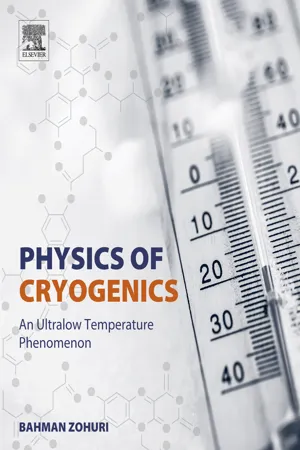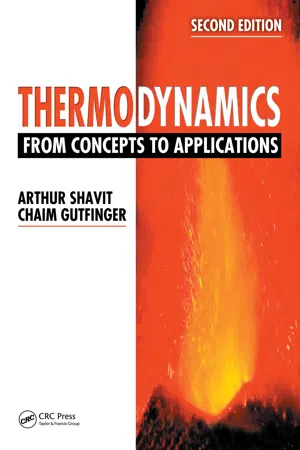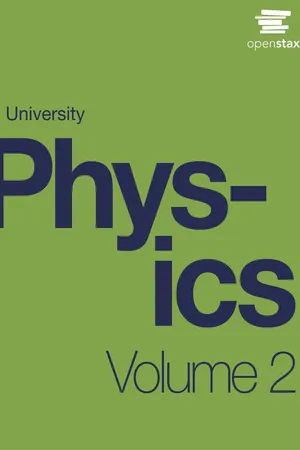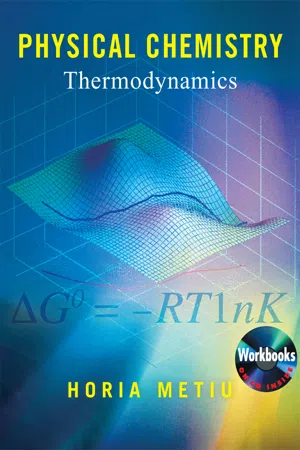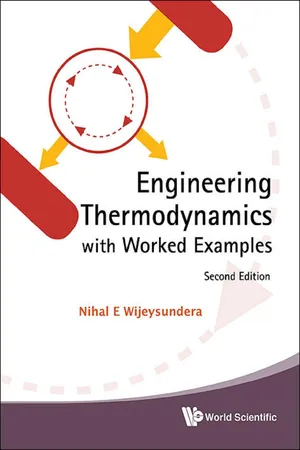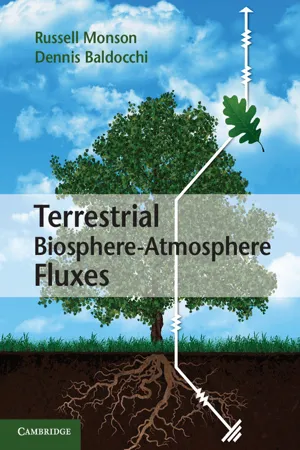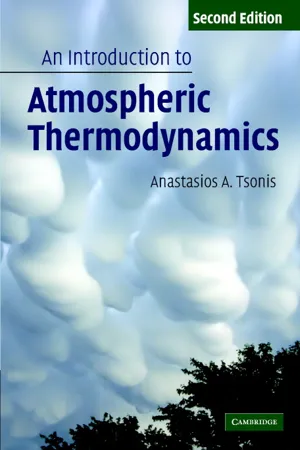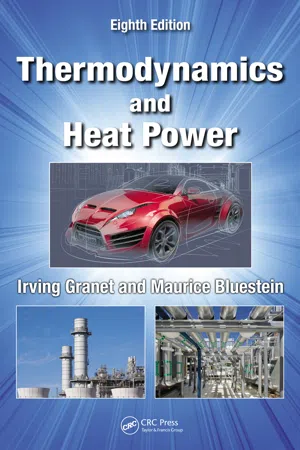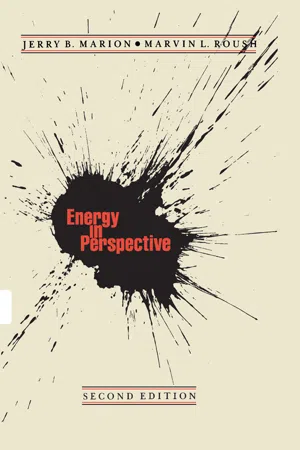Physics
Work in Thermodynamics
In thermodynamics, work refers to the transfer of energy from one system to another through the action of a force. It can take various forms, such as mechanical work, electrical work, or pressure-volume work. Work is a crucial concept in understanding the behavior and transformations of energy within thermodynamic systems.
Written by Perlego with AI-assistance
Related key terms
1 of 5
12 Key excerpts on "Work in Thermodynamics"
- eBook - ePub
Physics of Cryogenics
An Ultralow Temperature Phenomenon
- Bahman Zohuri(Author)
- 2017(Publication Date)
- Elsevier(Publisher)
These may be called energy transfer or energy interactions and they bring about changes in the properties of the system. Positive work occurs when the system transfers energy to its surroundings by some mechanical or electrical process. Positive heat transfer occurs when the surroundings transfer thermal energy to the system. Normally a temperature difference is the driving potential that moves thermal energy into or out of a system.4.2. Definition of Work
The formal definition of work is “a force acting through a distance.” When a system undergoes a displacement due to the action of a force, work is taking place and the amount of work is equal to the product of the force and the displacement in the direction of the force. The term work is so common with many meanings in the English language that it is important to be very specific in its thermodynamic definition.4.2.1. Work Is Done by a Force as It Acts Upon a Body Moving in the Direction of the Force
If the force acts, but no movement takes place, no work is done. Work is performed by the expanding exhaust gases after combustion occurs in a cylinder of an automobile engine as shown in Fig. 4.1 . In this case the energy produced by the combustion process can be transferred to the crankshaft by means of the connecting rod, in the form of work. Therefore, the work can be thought of as energy being transferred across the boundary of a system, the system being the gases in the cylinder.A similar concept is the work done in the turbine to generate electricity in a nuclear power plant. The gas pressure rotates the turbine blades producing a torque that turns a generator. Thermal energy is transferred from the reactor core to the steam generator in the first loop. The second loop then uses this steam to drive the turbine. See Fig. 4.2 - eBook - PDF
Thermodynamics
From Concepts to Applications, Second Edition
- Arthur Shavit, Chaim Gutfinger(Authors)
- 2008(Publication Date)
- CRC Press(Publisher)
So far, only the modes of work, where the force and the displacement can be easily iden-tified, have been considered. In works associated with electric, magnetic, and other phe-nomena, it may be difficult to identify the force and the displacement. The definition of Work in Thermodynamics is more general and covers all its possible modes, including the work in mechanics. 3.2 Work in Thermodynamic Systems In thermodynamics, work is defined as follows: Work is an interaction between two systems, such that whatever happens in each system and its bound-ary could have happened, exactly, while the only effect external to that system would be a change in the level of a weight in a gravitational field. 22 Thermodynamics: From Concepts to Applications Work, by definition, is an interaction; hence, it requires at least two systems. Indeed, there is no meaning to work if only one system is involved. Not every interaction, however, is work. For an interaction to be considered work, two tests must be devised, one for each system. Each test should be such that the tested system and its boundary follow exactly the original process, with the only effect outside the system being the change in the level of a weight. Finding a test system is not always self-evident and may require some imagination and idealization. The following examples clarify this point. Example 3.1 Consider a weight attached by a string, passing over a frictionless pulley, to a block slid-ing on a horizontal plane (Figure 3.1). Lowering the weight causes the block to slide on the plane overcoming friction. By defining the block and the plane as system A and the weight as system B, an interac-tion between systems A and B can be identified. This interaction may be recognized by observing the motion of the stretched string at the boundary. - eBook - PDF
- William Moebs, Samuel J. Ling, Jeff Sanny(Authors)
- 2016(Publication Date)
- Openstax(Publisher)
Here, we want to understand how work is done by or to a thermodynamic system; how heat is transferred between a system and its environment; and how the total energy of the system changes under the influence of the work done and heat transfer. Work Done by a System A force created from any source can do work by moving an object through a displacement. Then how does a thermodynamic system do work? Figure 3.4 shows a gas confined to a cylinder that has a movable piston at one end. If the gas expands against the piston, it exerts a force through a distance and does work on the piston. If the piston compresses the gas as it is moved inward, work is also done—in this case, on the gas. The work associated with such volume changes can be determined as follows: Let the gas pressure on the piston face be p. Then the force on the piston due to the gas is pA, where A is the area of the face. When the piston is pushed outward an infinitesimal distance dx, the magnitude of the work done by the gas is dW = F dx = pA dx. Since the change in volume of the gas is dV = A dx, this becomes (3.3) dW = pdV . For a finite change in volume from V 1 to V 2 , we can integrate this equation from V 1 to V 2 to find the net work: (3.4) W = ∫ V 1 V 2 pdV . 112 Chapter 3 | The First Law of Thermodynamics This OpenStax book is available for free at http://cnx.org/content/col12074/1.3 Figure 3.4 The work done by a confined gas in moving a piston a distance dx is given by dW = Fdx = pdV . This integral is only meaningful for a quasi-static process, which means a process that takes place in infinitesimally small steps, keeping the system at thermal equilibrium. (We examine this idea in more detail later in this chapter.) Only then does a well-defined mathematical relationship (the equation of state) exist between the pressure and volume. This relationship can be plotted on a pV diagram of pressure versus volume, where the curve is the change of state. - John Reisel(Author)
- 2021(Publication Date)
- Cengage Learning EMEA(Publisher)
Work, W, is simply a force, F, acting through a displacement, dx: W 5 # F ? dx (2.11) The rate at which work is done is called the power, W ? , and is equal to W ? 5 dW dt (2.12) As stated before, work is not a property of a system, but rather is a description of the thermo- dynamic process—therefore, the symbol used for the differential in Eq. (2.12) is a d rather than a d; this indicates that the work is a path function (dependent on the thermodynamic process taken) rather than a point function (dependent on only the thermodynamic state, such as a property). Any combination of a type of force acting through a type of displacement yields a mode of work. Unlike heat transfer, therefore, it is possible that the number of possible work transfer modes is limitless. However, there are only a few work transfer modes with which we will be concerned with in basic thermodynamics. In the following subsections, we describe several of the more commonly used work modes in basic thermodynamics. 2.5.1 Moving Boundary Work When the physical size of a system changes during a process, the expansion or contraction of the system occurs as a result of moving boundary work. An example of moving boundary work is the expansion of a balloon as air inside the balloon is heated, such as in Figure 2.18. The increase in the temperature of the air will correspond to an increase in volume, as we will see in Chapter 3, and the expansion will cause the system to do work on the surroundings. Another example is the air located inside a piston–cylinder assembly shown in Figure 2.19, such as in an FIGURE 2.17 The sign convention for heat transfer is that heat transfer into a system is positive, and heat transfer out of a system is negative. System System Q = –10 kJ Q = +10 kJ QUESTION FOR THOUGHT/DISCUSSION For each of the heat transfer modes, what are two or three commonly encountered situa- tions in which that mode will be dominant? Copyright 2022 Cengage Learning.- eBook - PDF
Physical Chemistry
Thermodynamics
- Horia Metiu(Author)
- 2006(Publication Date)
- Taylor & Francis(Publisher)
An equilibrium transformation is defined by indicating the initial state, the final state, and the path (see Chapter 4). I will show that the amount of work or heat exchanged between the environment and the system in a transformation depends on the path of the transformation. Not all quantities in thermodynamics have this property. For example, the molar volume of the system in the final state depends only on the final pressure and temperature; it does not depend on the path used to get the system into the final state. The Definition of Work §2. What is Work? You encountered work when you studied mechanics. In Thermodynamics, we use the same definition, but rewrite it to express work in terms of pressure and volume, instead of force and displacement. To explain how this modification is made, I use the “apparatus” shown in Fig. 5.1. The cylinder is filled with a gas that is in mechanical equilibrium with the weight on the piston. I want to make a transformation in which the piston is pushed down an infinitesimal distance dx . What is the mechanical work needed for performing this “experiment”? From mechanics I know that the work is the force multiplied by the displacement. The weight (the environment) is doing the work by pushing the piston against the pressure p exerted by the gas. The force opposing this process is F = pA (5.1) Figure 5.1 The force, F , acting vertically, displaces the piston a distance dx . The dotted lines show the position of the piston after the displacement. The Definition of Work 71 where A is the area of the piston. This force is vertical (perpendicular to the piston) and so is the displacement dx . Therefore the work performed in this transformation is (see your mechanics textbook) δ W = − F dx = − pA dx (5.2) The negative sign appears because the force pA acts upwards and the displacement is in the opposite direction. When the cylinder moves a distance dx its volume changes by an amount dV = A dx . - eBook - ePub
Engineering Thermodynamics
Fundamental and Advanced Topics
- Kavati Venkateswarlu(Author)
- 2020(Publication Date)
- CRC Press(Publisher)
In engineering thermodynamics, the focus will be on work-producing devices such as internal combustion engines and turbines. Hence, it is always suitable to consider such work as positive. That is, the work done by the system is positive, and the work done on the system is negative. In certain cases, however, it is convenient to regard the work done on the system to be positive. To reduce the possibility of misunderstanding in any such case, the direction of energy transfer is shown by an arrow on a sketch of the system, and work is regarded as positive in the direction of the arrow. It is necessary to know how the force varies with the displacement. This brings out an important idea about work.3.8 First Law of Thermodynamics
The first law of thermodynamics (conservation of energy principle) establishes the relationships among the various forms of energy and energy interactions such as heat Q and work W during a process. The first law of thermodynamics states that energy is neither created nor destroyed during a process; it gets transformed from one form to the other. When an electrical energy is supplied to a motor, it will rotate a pump circulating the fluid. In this case, electrical energy is converted to kinetic energy (rotation of the shaft). A speeding vehicle possesses kinetic energy, if the brake is applied it comes to rest slowly and at rest, it possesses potential energy. The loss in kinetic energy equals the increase in potential energy when the air resistance is negligible, thus confirming the conservation of energy principle for mechanical energy.The conservation of energy principle can be demonstrated with the help of the processes that involve either heat or work interactions or simultaneous heat and work interactions as well. In one case, we consider a process that involves heat transfer but no work interactions such as heating of a metal bar in a furnace. Owing to heat transfer to the metal bar, its energy increases. The increase in the total energy of the metal bar will be equal to the amount of heat transferred to it. Similarly, in the case of heating of water in a steam boiler, if 100 kJ of heat is transferred to the water from the furnace and 10 kJ of it is lost from the water to the ambient surroundings, the increase in energy of the water becomes equal to the net heat transfer to water, i.e., 90 kJ. - eBook - ePub
- Nihal E Wijeysundera(Author)
- 2016(Publication Date)
- WSPC(Publisher)
chapter 1 on the attributes of properties, we conclude that the kinetic energy is a property of the body.To evaluate the work done on the body, using the left hand side of Eq. (3.2) , we need to know how the force F varies with the displacement x . Therefore, the work done by the force is, in general, path-dependent. However, for certain forces like the gravitational force, the work done in moving the body from one point to another is independent of the path followed. Such a force is called a conservative force .The vector form of the expression for work done can be written aswhere F and are the force and position vectors respectively. The work, W however, is a scalar quantity. Note that the common units of work may be expressed as: [W ] = Nm (Newton-meter) = J (Joule).3.2Work Interactions in Thermodynamics
The interactions of a thermodynamic system with its surroundings occur at the system boundary. These interactions are usually the result of pressure forces, electrical currents, surface tension forces and others. For a concise formulation of the laws of thermodynamics we categorize all boundary interactions under two broad headings. These are called work interactions and heat interactions .3.2.1Criterion for a work interaction
It is possible to develop a criterion to determine unambiguously the nature of the interaction at a system boundary. A given boundary interaction is a work interaction if its sole effect on the surroundings could be resolved into the raising or lowering of a weight. In other words we should be able conceive of a device which when coupled to the given system (i) raises or lowers a weight in the surroundings using the same interaction, and (ii) leaves no other permanent effect on the surroundings. The concept is best illustrated using the piston-cylinder arrangement that has a gas, and an electrical heating element connected to a battery, as shown in Fig. 3.2(a) .Consider the gas as our system. As the gas expands due to heating, the piston will move up pushing the outside ambient air. There are two different boundary interaction that could be clearly identified. These are (i) the work done by the gas in raising the piston with the weight while pushing the outside air and (ii) the flow of electrical energy across the sections of the wire where they cross the system boundary. - Michael Clifford, Kathy Simmons, Philip Shipway(Authors)
- 2009(Publication Date)
- CRC Press(Publisher)
The change in internal energy of a closed system is equal to the sum of the heat transferred and the work done during any change of state. Thermodynamics 223 p 1 2 A B C v Figure 4.14 The application of the first law to two cycles with one process common to both allows the existence of internal energy to be proven and heat transfer, the energy of the surroundings must be depleted by the amount. This principle is depicted in Figure 4.15. How can different forms of energy be converted and transferred across the boundary of the system? The energy in the surroundings can be in any of several forms: potential energy, kinetic energy, strain energy, or internal energy. When the internal energy of a closed system is raised, energy is transferred from the surroundings through work and heat transfer. Two examples of ways this can be brought about are illustrated in Figures 4.16 and 4.17 and the following analyses. An Introduction to Mechanical Engineering: Part 1 224 Figure 4.15 Work and heat transfer are the mechanisms by which energy is transferred across the boundary of a closed system In Figure 4.17, air trapped in the cylinder by the piston is heated by heat transfer through the cylinder walls. As heat transfer occurs, pressure in the cylinder rises and the piston moves to the right.The position of the piston is dictated by equilibrium of forces acting on the piston: pA p a A F Thermodynamics 225 where p is the pressure inside the cylinder, p a is ambient pressure and F is the force exerted on the piston by the spring.The spring obeys Hooke’s law, such that the spring force is F kx where x is the compression of the spring from its unconstrained or free length and the spring constant k is 100 kN m 1 . If the area A of the piston is 0.01 m 2 , the pressure in the cylinder rises from 2 to 4 bar, and ambient pressure is 1 bar, calculate the work done on the air in the cylinder and the change in strain energy stored in the spring.- eBook - PDF
- Russell Monson, Dennis Baldocchi(Authors)
- 2014(Publication Date)
- Cambridge University Press(Publisher)
Energy is a scalar quantity that describes the amount of work that can be done in response to a specific force. Within the context of Newtonian physics, work is defined as a force (mass times acceleration) applied across distance (m). The relation between energy and work can be appreciated by consideration of the standard measure given to energy – a joule. A joule of energy is capable of supporting a “newton-meter” of work. A newton (N) is a unit of force defined as kg m s −2 , which in turn can be understood as the product between mass (kg) and acceleration (m s −2 ). Thus, a joule defines the work that can be done with a unit of energy within the context of position and momentum, two conjugate variables. (Conjugate variables are pairs of variables that interact mathematically in ways that define the thermodynamic potential of a system. Together, they form a type of time-dependent duality capable of relating incremental changes in the internal energy of a system to work.) The relation between work and energy can also be understood within the context of pressure and volume, two additional conjugate variables. The unit measure of pressure is N m −2 , and that of volume is m 3 . Thus, expansion of a system, which is defined as the product between pressure and volume, carries the same unit measure as that of work, the newton-meter, which is in turn equivalent to a joule of energy. Through consideration of units of measure alone, we can begin to appreciate the conceptual relations of the terms, energy and work. A number of theoretical treatments have attempted to categorize all components of the internal energy of a system into two fundamental types – potential energy and kinetic energy. Potential energy is the internal energy stored within a system that has the potential to do work. Potential energy can be converted to kinetic energy as work is done. Kinetic energy is the work required to accelerate a unit of mass to a given speed. - Anastasios Tsonis(Author)
- 2007(Publication Date)
- Cambridge University Press(Publisher)
28 4 THE FIRST LAW OF THERMODYNAMICS Figure 4.1 The shaded area gives the work done when a system changes from an initial state i to a final state f . V f V V i p p f f W = pdV f i i p i Figure 4.2 The shaded area gives the work done during a cyclic reversible transformation. p W = A i1f 2i 1 2 V f V V i f i from f to i along exactly the same path in the (p, V ) diagram. Then, the total work done will be W = f i pdV + i f pdV = f i pdV − f i pdV = 0. If, however, the system expands from i to f and then contracts from f to i but along a different reversible transformation (different path), then the total work done would be (see Figure 4.2) W = f i pdV 1 + i f pdV 2 = area under curve 1 − area under curve 2 = A i1f 2i = 0 where A i1f 2i is the area enclosed by the two paths. It follows that dW = pdV = 0 and thus dW is not an exact differential, which means that work is not a state function. As such it depends on the particular way the system goes from i to f . Because of this from now on we will denote the incremental change in work as δW not as dW . 4.2 DEFINITION OF ENERGY 29 If we write dV = dAds (where dA is an area element and ds a distance element) we have that δW = pdAds = F ds = Fvdt or that δW dt = Fv or δW dt = m dv dt v or δW dt = d dt 1 2 mv 2 or δW dt = dK dt (4.1) where v denotes the velocity of the parcel and K is the kinetic energy of the parcel. It follows that the work done and the kinetic energy are related. The last equation indicates that one way by which a thermodynamic system can exchange energy with its envi- ronment is by performing work. The other is through transfer of heat. More on that will follow soon. According to (4.1) the units for work are those of energy. Thus, the unit for work in the MKS system is the joule which is defined as J = N m where the newton N = kg m s −2 . In the cgs system, the unit is the erg which is defined as erg = dyn cm where dyn = g cm s −2 .- No longer available |Learn more
- Irving Granet, Maurice Bluestein(Authors)
- 2014(Publication Date)
- CRC Press(Publisher)
This type of analysis is representative of a microscopic description of the processes occurring within the boundaries of the defined system, because the history of a single particle was followed in detail. Rather than pursue further the microscopic concept of matter, we shall be concerned with the macroscopic, or average, behavior of the particles composing a system. The macroscopic viewpoint essen-tially assumes that it is possible to describe the average behavior of these particles at a given time and at some subsequent time after changes have occurred to the system. The 60 Thermodynamics and Heat Power system changes of concern to us in this study are temperature, pressure, density, work, energy, velocity, and position. The power of the macroscopic approach lies in its ability to describe the changes that have occurred to the system without having to detail all the events of the processes involved. 2.2 Work The work done by a force is the product of the displacement of the body multiplied by the component of the force in the direction of the displacement. Thus, in Figure 2.1, the dis-placement of the body on the horizontal plane is x , and the component of the force in the direction of the displacement is ( F cos θ ). The work done is ( F cos θ ) x . The constant force ( F cos θ ) is plotted as a function of x in Figure 2.1b, and it should be noted that the resulting figure is a rectangle. The area of this rectangle (shaded) is equal to the work done, because it is ( F cos θ )( x ). If the force varies so that it is a function of the displacement, it is neces-sary to consider the variation of force with displacement in order to find the work done. Figure 2.1c shows a general plot of force as a function of displacement. - eBook - PDF
- Jerry B. Marion(Author)
- 2012(Publication Date)
- Academic Press(Publisher)
Chapter Æ* WORK , ENERGY , AND POWE R We all hav e some intuitiv e notion s abou t th e quantit y tha t is th e centra l topi c of thi s book— energy. We kno w tha t we must bu y gasolin e to suppl y th e energ y tha t run s our automobiles , and we pa y a monthl y bill to th e electri c compan y for th e electri c energ y tha t is delivere d to our homes . We understan d tha t coal, oil, and gas pla y importan t role s in supplyin g th e energ y tha t is necessar y for our everyda y living. But to pursu e our topi c in detai l we need mor e tha n thes e qualitativ e ideas . We need to understan d some of th e basi c physica l principle s tha t govern situation s involvin g energy . Befor e we can begin a meaningfu l discussio n of energ y problems , we mus t establis h th e languag e we will use. Tha t is, we must defin e th e term s and th e unit s tha t ar e necessar y to describ e variou s situation s involvin g energy . We will requir e only a few of th e larg e numbe r of th e term s tha t appl y to physica l quantities—primarily , work, energy, and power. Th e unit s we will use ar e metric units—meters , kilograms , and seconds , as well as a few derive d unit s such as watt s and kilowatt-hours . Thus , we will emplo y only a limite d vocabulary , one designe d to cover only th e situation s of immediat e interest . THE DEFINITION OF WOR K We frequentl y use th e ter m work in ordinar y conversation . We might say, for example , Tha t job require s a grea t dea l of work. Wha t does work reall y mean here ? If you lift a numbe r of heav y boxes from floor level an d plac e them on a high shelf, you will feel tire d afte r th e job is completed—yo u 9 10 2. WORK , ENERGY , AND POWE R will kno w tha t you hav e don e work. This is exactl y right. Gravit y pull s th e boxes downwar d and when you lift th e boxes, you ar e doin g work agains t th e gravitationa l force . In its physica l meaning , work alway s involves overcomin g some opposin g force .
Index pages curate the most relevant extracts from our library of academic textbooks. They’ve been created using an in-house natural language model (NLM), each adding context and meaning to key research topics.
